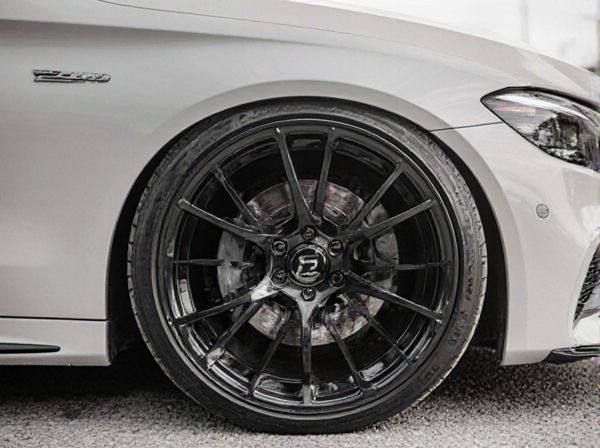
Photo illustration: Staggered vs Square Wheel Setup
Staggered wheel setups feature larger wheels and tires on the rear axle, enhancing traction and performance for rear-wheel-drive vehicles, while square setups use identical wheels and tires on all four corners, offering balanced handling and tire wear. You should consider a staggered setup if you prioritize aggressive styling and rear grip, whereas a square setup suits those seeking consistent handling and easier tire rotation. The choice impacts vehicle dynamics, cost, and maintenance, making it important to align with your driving needs.
Table of Comparison
| Aspect | Staggered Wheel Setup | Square Wheel Setup |
|---|---|---|
| Definition | Different wheel widths/diameters front to rear | Identical wheel widths/diameters on all four corners |
| Performance | Improved rear traction, better acceleration | Balanced handling, easier rotation |
| Handling | More rear grip, prone to oversteer | Neutral behavior, predictable cornering |
| Tire Rotation | Limited or no rotation possible | Full rotation possible for even wear |
| Cost | Higher cost due to specific tires | Lower overall maintenance cost |
| Ideal Use | Rear-wheel drive, performance cars | Daily drivers, balanced performance |
Introduction to Wheel Setups
Staggered and square wheel setups significantly impact vehicle performance and handling characteristics. A staggered setup features wider wheels on the rear axle, enhancing rear grip and stability, commonly utilized in rear-wheel-drive sports cars. In contrast, a square setup employs identical wheel sizes on all four corners, promoting balanced tire wear and predictable handling, often preferred in all-wheel-drive models for consistent traction.
What is a Staggered Wheel Setup?
A staggered wheel setup refers to a configuration where the rear wheels are wider than the front wheels, enhancing traction and stability by increasing the contact patch on the driven axle. This setup is commonly used in rear-wheel-drive sports cars to improve performance during acceleration and cornering. The wider rear wheels also contribute to an aggressive aesthetic and better handling dynamics compared to a square wheel setup, where all wheels share the same width.
What is a Square Wheel Setup?
A square wheel setup refers to a vehicle configuration where all four wheels have the same size and width, providing balanced handling and easier tire rotation. This setup often improves uniform wear and can offer better traction in specific driving conditions compared to staggered setups, which use different sizes on front and rear wheels. Square wheels enhance versatility by making tire replacement and maintenance more cost-effective and convenient.
Key Differences Between Staggered and Square Setups
Staggered wheel setups feature larger wheels and tires on the rear axle compared to the front, enhancing traction and aggressive styling primarily for rear-wheel-drive vehicles. Square wheel setups use identical wheels and tires on all four corners, promoting balanced handling, easier tire rotation, and uniform performance suitable for various driving conditions. Key differences lie in traction distribution, tire wear patterns, and setup expense, with staggered setups often providing better rear grip at the cost of reduced front traction and increased tire costs.
Performance Benefits of Staggered Wheel Setups
Staggered wheel setups feature wider rear wheels compared to the front, enhancing traction and stability during high-performance driving. This configuration improves cornering grip by optimizing tire contact patches on the driven wheels, resulting in better acceleration and handling dynamics. Manufacturers favor staggered setups in sports cars to balance weight distribution and maximize overall vehicle performance on both street and track.
Performance Benefits of Square Wheel Setups
Square wheel setups offer enhanced grip and handling stability by evenly distributing tire contact patches across the vehicle's chassis, optimizing traction during high-speed cornering. This configuration reduces understeer and oversteer tendencies, allowing for more predictable and precise control, which benefits track performance and spirited driving. Improved tire wear uniformity and balanced load distribution contribute to longer tire life and consistent performance throughout driving sessions.
Handling and Traction Comparisons
A staggered wheel setup, featuring wider rear tires, offers enhanced traction during acceleration and improved grip on dry pavement, benefiting high-performance rear-wheel-drive vehicles. In contrast, a square wheel setup with equal tire sizes front and rear provides balanced handling characteristics and more predictable cornering behavior, especially in slippery conditions. The staggered arrangement can induce understeer under hard cornering, while a square setup promotes neutral handling and better tire rotation options for even tread wear.
Suitability for Different Driving Styles
Staggered wheel setups, featuring wider rear tires, enhance traction and handling for high-performance and aggressive driving styles by improving rear grip during acceleration and cornering. Square wheel setups, with equal tire sizes on all corners, offer balanced handling and consistent grip, ideal for track driving and daily use where predictable performance and tire rotation flexibility are priorities. Drivers seeking optimized stability and grip during spirited driving often prefer staggered setups, while those valuing even tire wear and balanced performance lean toward square configurations.
Costs and Maintenance Considerations
Staggered wheel setups, featuring larger rear wheels and narrower front wheels, typically incur higher costs due to the need for different tire sizes and often specialized rims, resulting in increased tire replacement and maintenance expenses. Square wheel setups use identical front and rear wheel sizes, allowing for easier rotation and uniform tire wear, which can reduce ongoing maintenance costs and extend tire life. Budget-conscious vehicle owners may prefer square setups for their cost-efficiency, while staggered setups demand more frequent investment in tire-specific maintenance and replacements.
Choosing the Right Setup for Your Vehicle
Choosing the right wheel setup depends on your vehicle's performance goals and aesthetics. Staggered setups, featuring wider rear wheels, enhance traction and handling for rear-wheel-drive cars during high-speed cornering and acceleration. Square setups, with uniform wheel sizes on all corners, provide balanced handling and easier tire rotations, ideal for balanced driving dynamics and maximizing tire lifespan on all-wheel-drive vehicles.
 caratoz.com
caratoz.com